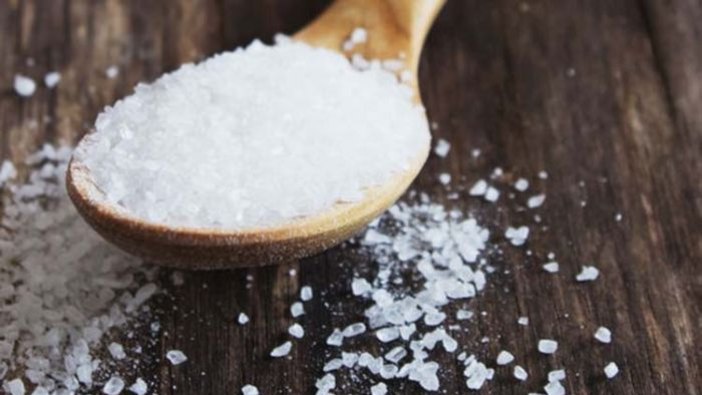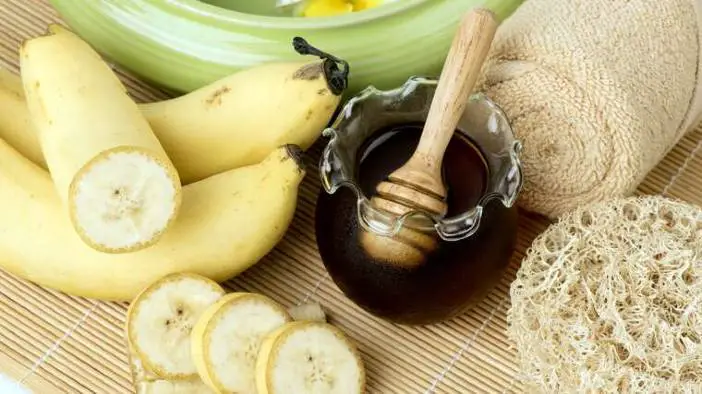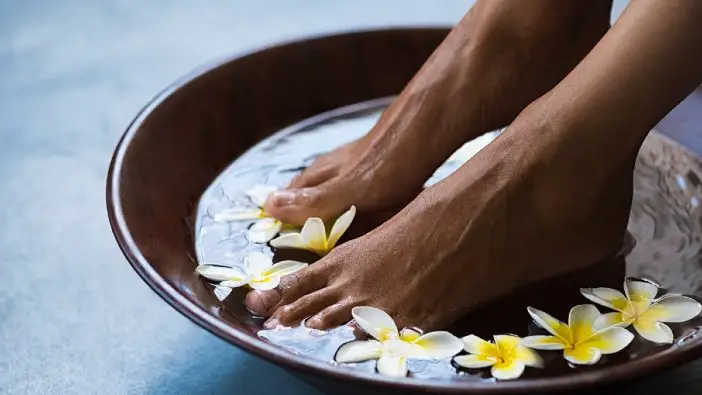Dry feet or cracked heels are not uncommon foot-related problems. They are as common as scalp dandruff. And, there is no limit to the population it affects. Before I show you how to cure dry feet, I need you to first understand that, most times it is not a cause for alarm.
Podiatrists, foot doctors, say dry feet aren’t always much of a concern. However, there may be cases of deep and painful cracks that may bleed. The good news is these dry skins are treatable and can get better.
This article outlines several easy home remedies to help you cure dry feet. You don’t have to break a sweat to get any of the materials. These options make use of readily available materials that do not cost a fortune.
Causes of Dry Feet
Dead skin builds up on the feet for many reasons. Emma McConnachie, a podiatrist, says “cracked heels are generally caused when the skin around the heels needs to split to cope with the pressure placed on the feet”.
This pressure can come from different factors that range from ordinary day-to-day activities to medical conditions. A prior understanding of the various causes will help you effectively cure dry feet. Here are the various reasons why your feet are dry and cracked:
- Lack of moisture on the feet
- Walking around barefoot
- Frequent wearing of open-back sandals
- Standing for long hours
- Aging
- Frequently taking long hot baths
- Wearing shoes that do not fit or support your heels
- Climate changes, especially low humidity, and cold temperatures
- Harsh chemicals from soaps
- Calluses
- Medical conditions like athlete’s foot, eczema, obesity, psoriasis, hypothyroidism, and diabetes.
- Deficiency in vitamins like vitamins B3, C & E
Home Remedies to Cure Dry Feet

1. Foot Soak and Scrubbing
This is probably the simplest home remedy for dry feet. Soak both feet in a bowl of lukewarm water for about 10 minutes. Gradually, the dead skin around the dry and cracked areas softens and loosens up.
Afterward, use a soft foot brush or scrub to gently brush off the loosened dry skin. Soaking your feet in warm water will improve blood circulation to your feet and allow healthier skin cells growth. Also, it can prevent drying in the future.
In addition, if you feel like it, you can add lemon juice or essential oils to your foot soak. In cases like dry feet due to athlete’s foot, add vinegar to the warm water. Vinegar has antimicrobial properties that will help to disinfect the feet and get rid of foot odor.
You should do this very frequently for effective results. However, if you’re using vinegar solution, it should be a few times. This is because frequent use of vinegar tends to dry out the skin. Also, apply a foot cream after scrubbing to restore moisture.
2. Pumice Stone or a Foot File

You can also use a pumice stone, a natural lava stone; or a foot file to remove dead skin cells from your feet. Here’s how to go about it:
- Soak your feet in warm water for about 10 minutes. This will help to loosen the dry skin
- While you wait, wet the stone and file with warm water
- Then, take your feet out of the water, one after the other, and scrub gently with the stone or file
- Afterward, rinse off the loosened skin that must have fallen off. You can repeat the step above and this step several times
- Dry your feet with a clean towel
- Lastly, apply a moisturizing cream or oil to your feet.
You can get a pumice stone or a foot file from any drugstore. Do not use a pumice stone or foot file on sores or open cracks.
3. Liquid Bandage for Dry Feet
A liquid bandage is a good option for bleeding cracks. It also helps to seal wounds from cracks; preventing further cracks and foot infections that may cause inflammation. Liquid bandages are sprays that should be applied directly to clean, dry skin.
Also, you do not have to worry about the bandage slipping or falling off. The spray forms a firm coat on the skin as the cracks begin to heal and close.
Read Also: 14 Easy Hacks to Help You Get Rid of Shoe Odor
4. Paraffin Wax
Paraffin wax is a colorless and odorless solid wax made from saturated hydrocarbons. When you apply paraffin wax to your skin, it moisturizes and makes your skin supple and soft. Also, it smoothens your skin by removing dead skin cells.
Melt paraffin wax in a steel pan and turn the liquid into a bowl. For ease, dip in one foot after the other. Dip each foot in until you are sure you’ll get a thick coat of wax. After that, wrap both feet in a plastic bag for the wax to harden.
Once you are sure the wax has hardened, you can remove the thickly layered wax. You’ll notice that layers of dry skin will come off with the wax.
However, there are exceptions to who can use paraffin wax. If you have open cracks or sores on your feet or poor blood circulation; you shouldn’t use the paraffin wax remedy for your dry feet.
In addition, be very mindful of the temperature of the wax before you dip in your feet.
5. Oatmeal and Rose Water Scrub
- Make a scrub of equal parts of oatmeal and rose water
- Apply the paste to your feet and leave it on for about 25 minutes
- Then, exfoliate gently with a soft foot brush
- After that, rinse off the paste and dead skin with cold water
- Allow your feet to dry and afterward moisturize them with a foot cream
- Do this regularly for effective results
6. Mouthwash and Vinegar
Mouthwash and vinegar contain compounds like alcohol and some mild acids that help to cure dry feet. They soften the dry skin and make exfoliation easy.
- Mix one part of a good mouthwash (for instance, Listerine), one part of vinegar, and two parts of water in a bowl
- Place both feet into the mixture and allow it to soak in for about 15 minutes
- Afterward, remove your feet from the mixture. Gently scrub each foot with a pumice stone to remove the dead skin
- Then, rinse off with clean cold water and dry your feet with a clean towel
- Most importantly, apply a moisturizing foot cream
- You should repeat this procedure every day until you can see the cracks and dry feet heal
7. Vaseline and Lemon Juice
Petroleum jelly is very versatile and has found universal usefulness, especially as a moisturizer. Lemons contain citric acid that softens dry, dead skin and fosters cells regrowth.
To use this remedy,
- First, you should soak your feet in warm water for 10-20 minutes and pat dry
- Next, mix one teaspoon of Vaseline with a few drops of freshly squeezed lemon juice
- Apply the mix to the cracked parts of your feet and your heels
- Lastly, wear a pair of woolen socks. Leave it on overnight
- In the morning, wash it off with warm water
- Do this every day before bedtime for effective results
8. Honey
Honey acts as a natural humectant. It helps the skin to draw moisture from the inner tissues to the outer layers, keeping the skin hydrated and soft. This property makes it effective for healing cracks.
- Mix honey with warm water in a ratio of 1:2-1:3
- Put both feet into the water and massage for an upward of 10 minutes
- Afterward, use a pumice stone to exfoliate dry skin
- Rinse and dry your feet with a clean towel
- Then, apply a moisturizing foot cream
9. Epsom Salt Soak

Epsom salt is a therapeutic bath salt that helps to relax muscles. Consequently, it softens the skin and reduces inflammation.
- Dissolve half a cup of Epsom salt in a basin of warm water.
- When you are sure it has dissolved well, dip both feet into saltwater and allow to soak for 15 minutes.
- Afterward, scrub your feet with a soft brush or foot scrub to remove the loosened skin.
- Lastly, rinse off with cold water and pat dry your feet.
- Do not forget to use a moisturizer.
10. Baking Soda Soak
Baking soda is a reliable exfoliant for removing dead cells from the skin. Also, it has great anti-inflammatory properties and helps to heal foot infections and fungus.
- Dissolve less baking soda in more water so it dissolves into a less concentrated solution.
- Then, soak your feet in the solution for 15 minutes
- After which you should remove your feet and scrub with a pumice stone
- Rinse off the solution and dead cells with clean cool water and pat dry with a clean towel
- Because of the acidity of baking soda, do this twice a week
- However, baking soda may cause irritations and dry out some skins. So, if you notice any irritation or a burning sensation, discontinue the use.
See Also: Best Essential Oils For Your Aromatherapy Uses
11. Vegetable Oil
Vegetable oils contain antioxidants and they have antimicrobial, anti-inflammatory, and healing properties. These qualities make them effective remedies for dry and cracked feet. People with deep and painful cracks can also do vegetable oil massage.
- First, you need to wash your feet and get them dry
- Apply sufficient vegetable oil to the cracks
- Then, wear a pair of thick socks made from natural material. You should have the oil and sock on overnight
- Wash the oil off your feet with cold water in the morning
- Repeat these steps every day before bedtime until you see results
12. Shea Butter Massage
Just like vegetable oils, shea butter contains vitamins A and E that confer its healing properties. Also, shea butter is a good moisturizer that hydrates and nourishes the skin with vitamins.
- All you need for this remedy is organic shea butter and a pair of thick socks.
- Massage shea butter into your feet and generously on the cracks and sores
- When you see that it has been properly absorbed, you can wear the socks and leave them on overnight
- Repeat this procedure every day before bedtime
13. Banana Mash Foot Mask

Banana contains vitamins that moisturize and hydrate the skin. These vitamins include vitamins A, B6, and C. Also, they help to maintain skin elasticity. Banana mash can be made with just bananas, bananas, and avocado, or banana and honey.
Whether you are using just bananas or you’re incorporating honey and avocado it follows a general procedure.
- Mash ripe bananas in a paste
- You may add honey or avocado if you wish
- Afterward, apply the paste over the cracks and dry areas
- Leave it on for 20-30 minutes, then, wash it off with lukewarm water
- Do this frequently and you’ll notice that the skin on your feet is soft and hydrated
14. Olive Oil
- Use a cotton ball to apply olive oil onto your feet
- Massage the oil into your feet in circular motions
- Thereafter, wear thick cotton socks and leave to soak in for about an hour
- Then, wash it off with clean water
Olive oil makes your skin soft and supple. However, some skin types react to olive oil. So, ensure you do a patch test before use.
Learn More: 15 Tips To Help Make Your Nails Stronger
15. Rice Flour, Honey and Vinegar Foot Scrub
- Make a scrub of rice flour, honey, and vinegar
- Ensure that the vinegar concentration isn’t too much
- Before you use the paste, first, soak your feet in lukewarm water for a while
- Then, use the paste to scrub off dead skin from your feet
- Repeat this procedure three times a week for optimum results
FAQs on How to Cure Dry Feet

1. Why do I have dry feet?
You could have dry feet because your feet are dehydrated. This is because the feet do not have oil glands that can keep them moisturized and hydrated. Consequently, the skin around the feet breaks into fine lines and cracks.
2. How do I prevent dry feet?
When you identify the cause of your dry feet, it becomes easier to prevent future occurrences. Meanwhile, to totally avoid dry feet, do not wear ill-fitting shoes and shoes that do not cover or support the heels.
Most importantly, the feet do not have any glands to help them retain moisture. So, you have to constantly keep your feet moisturized.
3. Does wearing socks help dry feet?
Yes, it does. Wearing socks can help reduce friction between your soles and your shoes. For instance, socks that are made from natural materials like wool and cotton are breathable. So, they do not allow your feet to sweat or dry out due to excess moisture.
Conclusion
Dry feet are not a cause for alarm unless you know they are a result of an underlying medical condition. But, most of the time, you can cure dry feet at home with household ingredients.
However, you shouldn’t expect magical action. The healing process works inside out. So, you need to be patient and continue using the treatments. Meanwhile, you should wear appropriate footwear and keep applying moisture.
Thanks for reading.
Check Africana Fashion for more relevant wellness articles.






